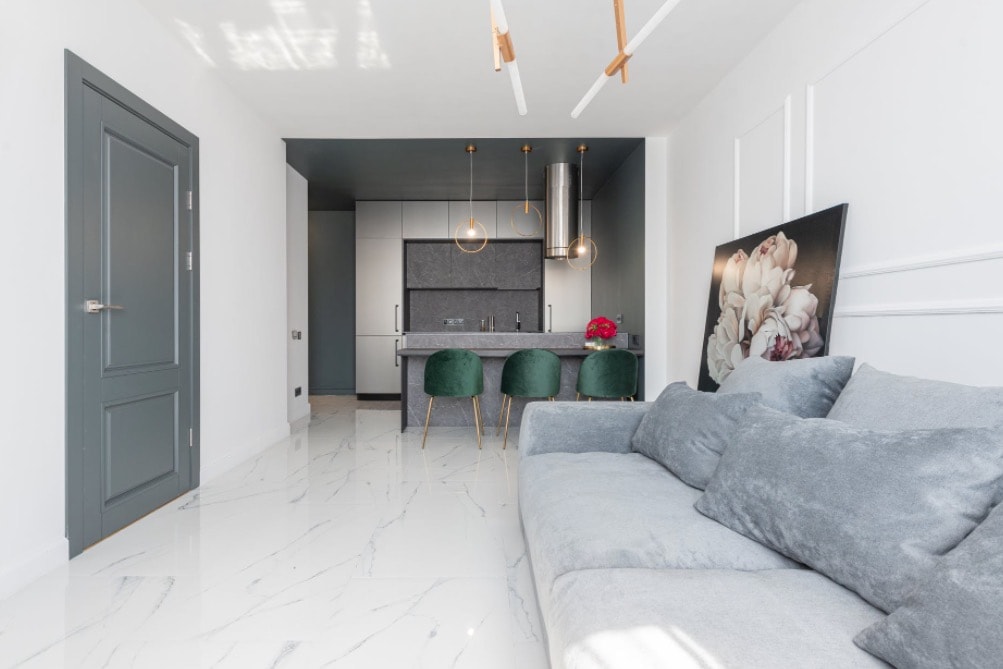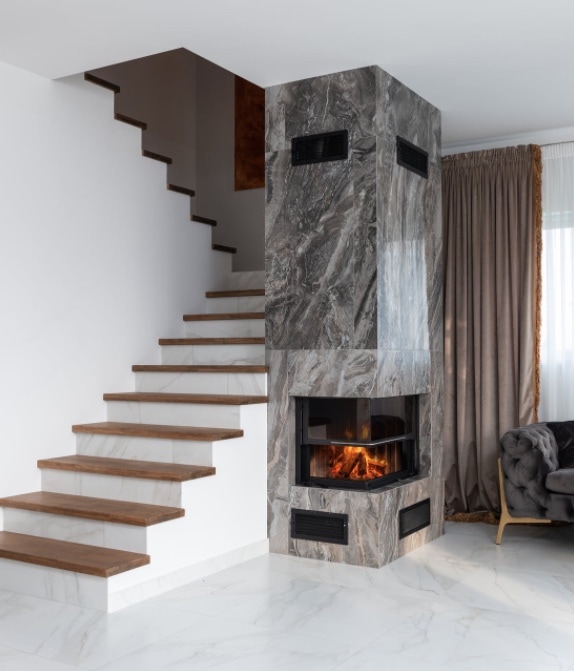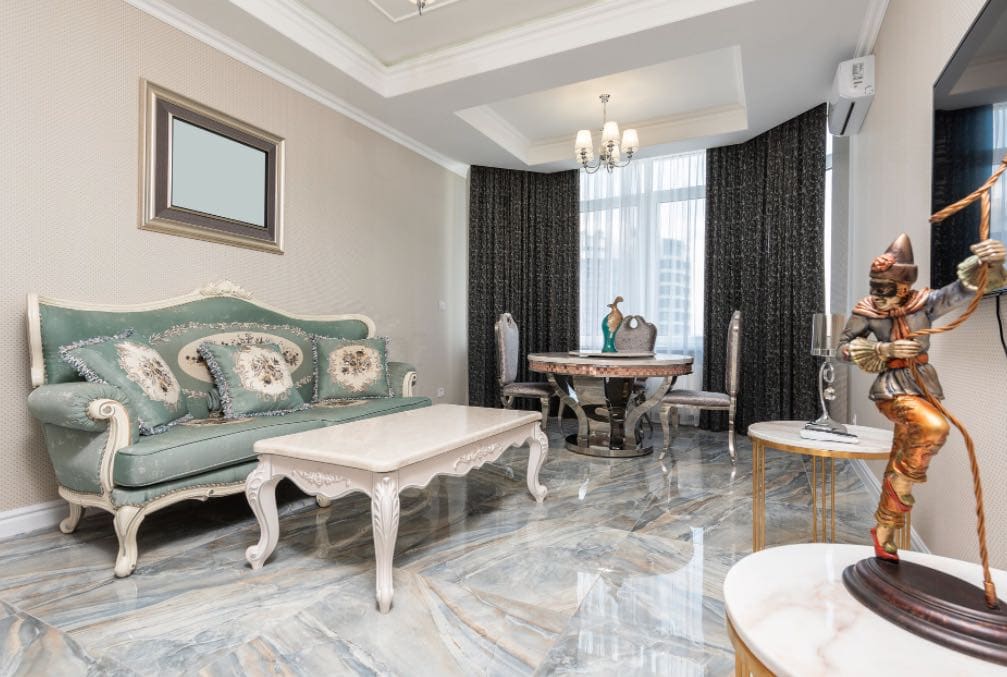The reasons why we, in general, love marble so much are numerous and include details such as the fact that marble is very easy to work with and can be milled, machined and tumbled, which allows it to have multiple uses. Marble floors are quite common, although less popular than marble counters or tabletops. But, of course, marble floors don’t suit every type of space. While searching for style ideas, you’ve probably come across hundreds of examples of glamorously tiled powder rooms, lavatories, or master baths and wondered why there are so many different tile looks and options and which tile is the best fit for your bath.
When you are tired of the flooring in your living room, or it’s plain worn out, you will want to choose something that will enhance the room in every way. So what flooring will give you the functions you need along with the appearance you want? It’s quite possible that marble flooring is just what you’re looking for. Its charm and beauty offer something other flooring styles just can’t.
Living Room Marble Floors
As mentioned before, marble is a material that stains and etches very easily, making it a poor choice for spaces such as the kids’ bathroom or the kitchen. The living room is a problematic case as well. Here, a marble floor can be easily damaged by many things, so make sure you consider everything before making a final decision.
Keep in mind that marble floors need to be sealed and maintained regularly if you want them to look beautiful for a long time and last longer. The living room is not exactly a space where you can make compromises, so be prepared.
If you decide to have a marble floor in your living room, you should maximize it as much as possible. Avoid covering it up with rugs, carpets, robust furniture and other objects and accessories.
The Challenge
Though indeed, furniture feet, pet claws, stiletto heels, and kids’ toys with wheels can damage a wood floor, any other material can feel substandard in these cozy common areas. “There’s a reason real estate ads mention wood floors,” Slaughterbeck says. “Hardwood also adds value to your home.”
Top Choice: Solid Wood
By this, we mean prefinished wood flooring such as the 14 products we tested (10 of which earned Very Good or Good scores overall), as well as unfinished wood flooring, which gets sanded and finished on site. (CR does not test unfinished floors because much of what we analyze is related to the finish.)
There are plenty of reasons to opt for prefinished planks. You won’t have dust from sanding or fumes from finishing to contend with during installation; depending on how it’s installed, you might be able to walk on the floors right away, and prefinished flooring also tends to be less expensive. Perhaps most importantly, the factory-applied finishes are significantly tougher-wearing than what your contractor would likely apply once the floor is installed.
Runner-Up: Engineered Wood
Though it mimics the look of solid wood, engineered wood flooring has just a thin veneer of finished wood, such as oak or maple, attached to plywood like a substrate. Engineered wood provides several significant advantages over solid wood. The varieties we tested cost $4 per square foot, on average; prefinished solid wood averages $5.86 per square foot. And with an engineered product, you can affordably get an exotic wood species, such as Brazilian walnut or tigerwood, both of which tend to be more scratch- and dent-resistant than oak or maple.
Engineered wood floors are also less susceptible to seasonal shrinking and swelling because the layers in the plywood backing are arranged with their grain in alternating directions. Some can even be installed directly over a concrete subfloor, which isn’t always possible with solid wood. In addition, engineered flooring is often low-profile enough to install over an existing floor—representing a huge potential saving. Still, this choice lacks the longevity of solid wood, particularly for the (very) long haul. In certain household environments, a wood floor might need refinishing every decade or two. Most engineered products can be refinished just once (depending on the thickness of the top “wear” layer) vs. solid wood, which can be refinished four or five times.
On the other hand, marble floors with soft and delicate veins and patterns can also look highly sophisticated and elegant, even more so if the rest of the décor is just as stylish and simplistic. High-end marble is usually defined by a soft and even colour palette and less pronounced veins.

FAQ About Marble Floors
Is marble flooring worth it?
The cost of marble tiles varies depending on the type, but generally, they are more expensive than porcelain tiles. But the benefit is that you have a unique and beautiful project that will be much less trendy than many ceramic tiles. Marble has a timeless quality to it.
Is marble flooring durable?
While marble is a durable flooring, it requires a little extra care to help it retain its beauty. Honed marble is more porous than polished marble, and it’s a good idea to seal a honed marble floor twice per year to help it resist staining. Use a mild, non-acidic floor cleaner for regular mopping.
Do marble floors increase home value?
Home improvements made with natural stone will always add value to residential properties, and marble has always been considered one of the best stones for homeowners seeking to boost their investments’ value.
Here Are A Few Of The Reasons Why Marble Flooring Is A Good Fit For Many Livings Rooms.
Reason 1: Unbeatable Elegance
You want your house to stand out as distinct and unique. With marble flooring in the living room, that space can do just that. People are used to seeing marble on countertops in the kitchen and flooring in the bathroom, but placing it in the living room is a bit more unique. You can pick whether you want a high gloss or more of a matte look for the flooring. But either way, its elegance and style are unsurpassed.
Reason 2: Color Range For Style Ease
Whether you want something stark and white or natural and brown, you can find it in marble. All of the natural stones have common colour palettes, though every tile grain will be different. So you’ll have elegance and uniqueness in every tile, and the colour range makes it easy to find something that will go along with the other colours you have in the house already.
Reason 3: Heavy-Duty Durability
Depending on your family, the living room can take a beating, and you will get easy maintenance and high durability in marble flooring. You can adapt the modern stone to many different styles over the years. Since it is so durable and long-lasting, you won’t have to change it out when you change other things around it. It certainly won’t look worn and tired the way other floors might after a few years.
Reason 4: High Levels Of Versatility
Marble flooring is a great solution for the floor because of its natural colours and wonderful options. You have a wide variety of styles you can place on top of a marble floor, and you can mix and match those styles. Marble fits in well to a modern home with stark black and white colour contrasts, but it also fits into a country-style home with warm tones and natural colourings.
Reason 5: Reflect The Light
You know that certain colours bring more light into a room, and light allows you to enjoy the feeling of more space. Marble flooring reflects light and gives you a natural feel that makes the room look a bit larger than before. It captures your attention when reflecting the light and stands out as something special in any living room.
Types Of Flooring To Consider
Hardwood Flooring
Hardwood flooring comes from a solid piece of milled wood and contains solid wood all throughout. Popular hardwood varieties include maple, oak, walnut or cherry. Its versatility and quality make it a desirable flooring option for many home buyers.
However, it’s one of the more expensive flooring materials on the market. It does take regular maintenance, such as using a specialty hardwood floor cleaner once a month and applying a fresh coat of finish every three to five years to keep them looking great. The average cost for installed hardwood flooring is $5 to $10 per square foot.
Pros
- Increases home value
- It can be refinished multiple times
- Many options available
- Strong and durable
Cons
- Expensive
- Can incur scrapes, scratches and dents in high-traffic areas
- Susceptible to moisture damage
- Not suitable for bathrooms, laundry rooms and basements
Laminate Flooring
Laminate is an affordable flooring option for homeowners who prefer an alternative to carpet but want to avoid the cost of hardwood or tiles.
The floors consist of a particleboard wood base topped by wood or tile photo beneath a clear plastic protective layer. This flooring is very DIY-friendly, and laminate offers a multitude of texture and colour options. The average cost for installed laminate flooring is $3 to $7 per square foot.
Pros
- Inexpensive compared to wood
- Easy to clean
- Scratch-resistant
- DIY-friendly
- Many styles and colours are available
Cons
- Susceptible to moisture damage
- Chips easily
- It does not look and feel like wood
- It has a hollow sound underfoot
Tile
Tile flooring is a popular choice for moisture-prone areas like bathrooms and kitchens. The most common tile materials are ceramic or porcelain. Tile is water-resistant, durable and comes in a variety of styles and colours.
The installation cost varies depending on the material; for instance, glazed ceramic is less expensive than porcelain tile. However, the average cost ranges from $2.50 per square foot for ceramic tile and $3 to $10 for porcelain tile.
Pros
- Waterproof
- Durable
- Long-lasting
Cons
- Expensive
- Hard to install
- A lot of prep work is needed before installation
- Cold and slippery
Engineered Wood Flooring
Engineered wood flooring offers the look of real wood at a more affordable price than solid wood. The floor features a thin layer of hardwood bonded over a high-quality plywood substrate. It’s as durable as solid hardwood flooring and can last as long with proper care.
Engineered wood flooring is a good choice for DIYers to install, which will save you money on installation costs. The average cost for installed engineered wood flooring is $4 to $9 per square foot.
Pros
- DIY-friendly
- Has real hardwood top layer
- Greater resistance to moisture and water than real wood
- Less likely to warp
- Multiple installation methods
Cons
- It can’t be refinished more than once
- Not fade-resistant
- Wide variation in quality
- Can sound hollow underfoot
- Emits VOCs
Linoleum Flooring
Linoleum is a durable, eco-friendly flooring option made from linseed oil and cork. Linoleum flooring is affordable and easy to install. The flooring comes in sheet form and a variety of colours and styles. It is resilient (made with elastic materials) and can last for decades if cared for properly.
Linoleum is gaining in popularity as flooring manufacturers offer more modern colours and styles. However, the average cost to install linoleum flooring ranges from $4 to $8 per square foot.
Pros
- Inexpensive
- Eco-friendly
- DIY-friendly
- Available in a variety of colours and patterns
- Requires little maintenance
Cons
- It does not increase home value.
- Easily dented or cut.
- May darken or turn yellowish when exposed to sunlight.
- Not suitable for moisture prone-areas
Marble Flooring
Marble flooring is being used for centuries for residential houses. However, there are several advantages and disadvantages of marble flooring, which a homeowner must know before either installing or renovating the flooring. Here we give brief advantages and disadvantages of marble flooring.
Pros
- Marble is available in a broad range of colours, patterns and designs. Thus you can select from a variety of designs. No other material looks as elegant and beautiful as marble.
- It has a very smooth finish, and when polished, it gives a luminous shine.
- As marble is a translucent material, when exposed to sunlight, marble flooring glows and increases radiance in the room.
- For hot climates, marble flooring is favourable as one feels relatively cold underfoot.
- It is soft, tiles of exact dimensions can be easily cut, and edges can be moulded, shaped, etc.
- The joints of marble tiles can be easily matched.
- It gives a soft appearance as compared to granite.
- It is an eco-friendly material as no chemical process is involved in its manufacturing. Also, it is completely degradable at the end of its life.
- It looks excellent when mirror polished.
Cons
- Marble is a natural composition; hence each piece is unique and different from another. Hence, if not skillfully, it may look awkward and unpleasant.
- Marble flooring gets very cold in the winter season. Hence, it is not suitable for very cold weather regions, as you cannot walk barefoot on it.
- Marble flooring is very expensive as compared to other flooring materials.
- In marble flooring, there is an enormous amount of waste generated in cutting the marble, as each piece is different, and particularly when you have to match the design, sizing and veins.
- Marble is a natural material that reacts easily with acid. Their interaction results in stains on its surface.
- Also, it is a porous material, and stains will be easily formed due to the spillage of liquids such as tea, curry, dal, coffee, wine, juices, sauces, etc.
- Marble is innately a softer stone, which makes it susceptible to scratches from sharp or hard objects. Also, marbles like Italian marble are very soft and are prone to cracking and chipping.
- Installation of marble flooring is very time consuming and requires skilled labourers, particularly when you have to match the veins of marble.
- Marble flooring requires proper care and maintenance. Marble flooring should be regularly polished periodically.
Make Marble Part Of Your Walls Or Floors

The “or” part is key in this instance. For example, if both the walls and floors were covered in marble, the space might end up looking too stark and cold. However, by choosing one, you can tie just a touch of classical feel into the space while tying it in with more modern materials. Whichever element you pick, there are a variety of ways to execute the design.
Think about adding marble to the backsplash in your kitchen. Use marble as an alternative to traditional wainscoting in your bathroom or dining room. Add a pinch of marble to your living space by encircling the room with a marble chair rail.
A foyer is a great option if you would rather add marble to the floor since it is traditionally a more formal space. Add an artistic flourish to your dining room at a low cost by using marble to create a design that anchors your dining room table. In addition, marble flooring could add a luxury feel to anyone’s master bathroom.
Getting Marble Flooring Installed
If you are ready to dig deeper into the marble flooring options, contact the professionals at Impression with your questions. Look over the colour options and learn more about marble maintenance before you agree to the installation process.
Because marble contains minerals, its iron content turns to rust over time, especially when exposed to high humidity. So while it might not be advised to have marble flooring in bathrooms and showers, hallways are a whole different story.
There are different flooring options available to you, but when you live in an almost always sunny and warm place, the best option is something that keeps your home cool. Marble flooring is one of the options that can help keep your home cooler, especially during the summer. The material is a type of rock derived from limestone and formed by going through high amounts of heat and pressure underground. The way marble is formed denser, harder, and more durable than other commonly used materials for tiles, like porcelain, wood, and ceramic.
Even when the rest of your home feels hot and humid, your marble flooring will still remain cool. Often, you will find that it feels colder than the other surfaces in your home. This is because the rock conducts heat differently. Its high density and hardness enable heat to transfer from a warm object, like your soles. However, heat dissipates fast through marble, too, so the flooring does not feel warm. Fibres and small air pockets in those materials heat up with carpeted or wood flooring, but the hot air does not dissipate quickly, causing a warm sensation.
